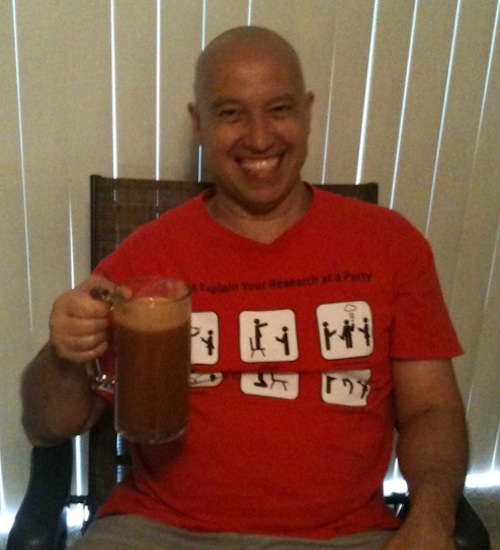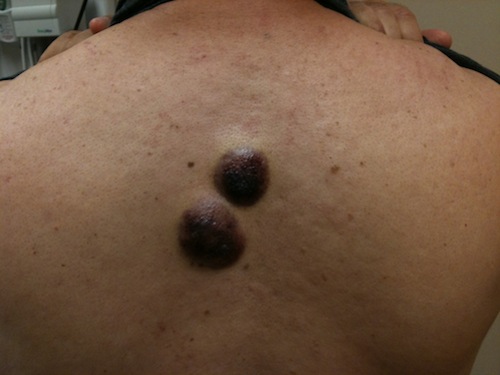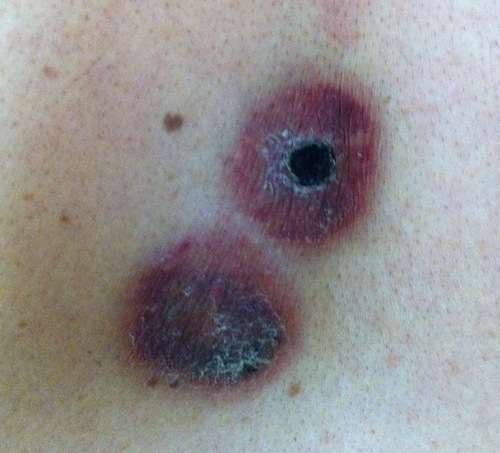Christian-History.org does not receive any personally identifiable information from the search bar below.
Blastic Plasmacytoid Dendritic Cell Neoplasm:
Why There's Hope!
In July, 2011 I was diagnosed with Blastic Plasmacytoid Dendritic Cell Neoplasm (BPDCN). I am writing this page to spare you the shock that I experienced when I searched this horrifying version of leukemia on Google. (BPDCN has been considered a lymphoma in the past. It is hard to classify.)
Ad:
Our books consistently maintain 4-star and better ratings despite the occasional 1- and 2-star ratings from people angry because we have no respect for sacred cows.
Let's begin by saying that web pages on BPDCN present a hopeless outlook. Ten years ago, that was an accurate outlook. Today, BPDCN is cured almost as easily (and regularly) as Acute Myeloid Leukemia (AML), to which it is related.
Admittedly, that's not a very good prognosis. AML survival rates are still only around 30%, and if you're diagnosed over the age of 70, it's worse because treatments, as well as your ability to survive the treatments, are more limited.
NOTICE!! I AM NOT A DOCTOR!
I am a fellow patient. My leukemia turned out to be an Acute Undifferentiated Leukemia (AUL) related to Blastic Plasmacytoid Dendritic Cell Neoplasm, but I did a lot of research on BPDCN. Even now, the treatment for my AUL is affected by its similarity to BPDCN.
I have read medical papers published on the PubMed database concerning BPDCN. I have run my conclusions by my doctors at the Vanderbilt Medical Center in Nashville, Tennessee in the process of determining my treatment. The information I'm giving on this page is well-researched, and I have been very careful to make sure it's double-checked and accurate. Nonetheless, I am not a doctor.
This is meant to be helpful, hopeful, and very accurate (as of 2011) advice for fellow patients. You will not survive Blastic Plasmacytoid Dendritic Cell Neoplasm without being treated by a competent doctor in an excellent medical facility.
Contact the Leukemia and Lymphoma Society to ask about financial options if you do not have insurance and cannot afford treatment at a good hospital.
Here's Why the Web Sites are Wrong and You Can Survive.
Most web sites that pass on the awful prognosis normally associated with Blastic Plasmacytoid Dendritic Cell Neoplasm are basing their information on old data.
 Juicing between chemo, hoping that maybe good nutrition would help me handle the process. You can't juice during chemo because raw veggies have bacteria that are dangerous when blood counts are low.
Juicing between chemo, hoping that maybe good nutrition would help me handle the process. You can't juice during chemo because raw veggies have bacteria that are dangerous when blood counts are low.Years ago, perhaps even as recently as 2006, BPDCN was treated like other acute leukemias. Chemotherapy was given to put in remission, and then the doctors would wait to see if it would stay in remission.
Unfortunately, unlike other acute leukemias, Blastic Plasmacytoid Dendritic Cell Neoplasm almost never stays in remission. It always relapses, usually in under one year, and then the patient dies. It appears to me from reading the medical papers that no one has ever successfully treated BPDCN after a relapse.
This is different than almost all other acute leukemias. With other acute leukemias, you can achieve a second remission. Not so with BPDCN.
Therefore, once BPDCN is put in remission by chemotherapy, a stem cell transplant must be performed within a few months!
In the last few years, as medical professionals have discovered that a stem cell transplant (or bone marrow transplant) must be performed, hospitals have begun complying, and BPDCN victims are beginning to survive on a regular basis.
The problem is that survival rates for leukemia are based on a 5-year period. Most of the people properly treated for BPDCN have been cured in the last three years. Thus, the figures for 5-year survival rates are still look awful.
I am in contact with a man in North Carolina who has been clear for three years. I am in contact with another man in Ireland who has been clear for 16 months (as of October, 2011).
There are many others. One of the studies that looks awful is one by Dalle et al. The abstract says, "Only eight (17%) and one (2%) patients reached respectively 2 and 5 years of survival."
Sounds terrible, right? However, if you purchase the entire paper published in the British Journal of Dermatology, you find out that only ten of the cases they studied included a bone marrow transplant. The paper is old enough to include cases in which the doctors did not know how mandatory a transplant is for BPDCN sufferers.
Of the ten people transplanted, six of them were still alive at the end of the study. On average, they had been alive for two-and-a-half years (31.3 months). One of them had already survived 77 months.
Blastic Plasmacytoid Dendritic Cell Neoplasm is still a terrible disease. The older you are, the more terrible a disease it is because the treatment could kill you even if the disease does not. But it is not the certain death that a Google search would seem to indicate.
My Shocking Google Search
I described my experience with googling "blastic plasmacytoid dendritic cell neoplasm" on my Thrilled to Death blog. Here I'll just give you the list of quotes I found on the sites that came up on the first page of my Google search.
- "Despite the initial response ... being mostly excellent, the prognosis is poor"
- "this aggressive hematological disorder"
- "which is VERY RARE [caps in original] and according to the Internet not curable and usually presents with skin lesions [note: I have these]. There are very few cases reported and not very good outcome."
- "Systemic dissemination and short survival are characteristic." [Keep in mind here that "systemic dissemination" means having leukemic symptoms, which I have.]
- A very rare aggressive cancer that manifests in skin lesions ... No long term treatment has been developed ... to date. Life expectancy is estimated at twelve to fourteen months. Chemotherapy offers a short term remission (approx. three months). A bone marrow transplant extends lifetime up to three years.
- The prognosis ... is generally poor with a median survival of 14 months. The treatment is conventional chemotherapy for AML, which generally shows a good initial response followed by QUICK AND FATAL RELAPSE.
I wrote this page because quotes like that took my breath away when I read them on the internet. I seriously hope that this page will make it onto the first page of Google so that others will get a more up to date account of Blastic Plasmacytoid Dendritic Cell Neoplasm.
What the Heck Does Blastic Plasmacytoid Dendritic Cell Neoplasm Mean, Anyway?
The words in Blastic Plasmacytoid Dendritic Cell Neoplasm actually mean something:
- Blastic
- A blast is an immature cell. The defect in Blastic Plasmacytoid Dendritic Cell Neoplasm occurrs at the immature stage of the development of the blood cells.
- Plasmacytoid Dendritic Cell
- Plasmacytoid dendritic cell (pDC) is the name of a type of blood cell. There are also myeloid dendritic cells in our immune system. The pDC's, however, are similar to plasma cells, so they are called "plasmacytoid." I don't understand their function real well, but basically pDC's hang out mostly in the skin, nasal passages, and other areas exposed to the outside world. They recognize dangerous invaders ("pathogens") like viruses and present them to T-cells (and B-cells?) for destruction.
- Neoplasm
- A neoplasm is a tumor. Most often, the first indication of BPDCN are lesions on the skin. These are actually tumors.
Thus Blastic Plasmacytoid Dendritic Cell Neoplasm basically means "A tumor caused by immature dendritic cells of the plasmacytoid type."
My Experience Somewhat Briefly
You can follow my entire experience at http://yippee-leukemia.blogspot.com, my Thrilled to Death blog, but here's the short version.
Long about late March of 2011, I developed a small bump on my back that I thought was a bug bite. It itched a bit. I thought it went away, but a couple weeks later I noticed it was still there but bigger.
About a month later I developed another very close to the first. By late april, the first bump was almost the size and shape of a Florida palmetto bug—about an inch long, half inch wide, quarter inch high, and roughly oval.
In May, my wife told me the bumps were blue. I had not realized that. They were in the middle of my upper back, not a spot that's easily visible even in the mirror. (At least not for a 49-year-old. I suspect I was able to turn my head more when I was younger.)
I had been trying to get in shape ever since a doctor gave me a physical back in September (2010). My blood counts were normal then, but my blood pressure was barely high. The doctor told me to lose 30 pounds.
I lost 10 pounds in the fall, and I was running 2 miles at a time. I slacked off over the winter as I really didn't seem to be progressing, which I chalked up to being overweight. The discouragement and the cold weather led to me taking a couple months off. I was pretty sure once I lost some more weight, my running would improve. (That's acually what happened when I took up jogging at 40, too, so experience backed up my assumption.)
It wasn't until May that I began to realize that not only was I not getting better, I was getting worse.
I never dreamed that something drastic was wrong with me. I am prone to harmless cysts. I have had a number of them, and I was sure that was the issue with my back.
By June the bumps on my back had not only become larger, but they no longer looked like cysts. The skin had become bumpy and had turned a rust color, rather than blue and smooth as they had been.

We never got a picture of the lesions at their worst. This is in June sometime. In early July, the top one grew so quickly that it tore my skin, leaving a scab that can be seen in the picture below, after the chemotherapy shrunk the tumors to nothing.
So on June 21, 2011 I went to see my doctor. Even with the bumps in the condition they were in, he thought they were cysts. We even scheduled an appointment for the following week to have them removed by a surgeon.
On June 24, however, he called me back in to tell me that my blood test showed that I was anemic. He had looked at my blood under a microscope, and all my lymphocytes (a type of white blood cell) were large and abnormal. My white blood cell count was almost double what it should be, yet my neutrophils (the type of white blood cell that fights bacteria) were barely visible under the microscope.
He told me he was certain I had leukemia.
I went to Corinth, MS for more tests the following week, and they took a bone marrow biopsy. The following week the doctor told me that I had an acute leukemia, but that my bone marrow was so unusual that he wanted to turn me over to a bigger hospital. He specifically recommended two doctors at Vanderbilt University.
The first week of July I went to Vanderbilt, where I was told that the pathology lab in California (yeah, my bone marrow went to California) diagnosed me with Blastic Plasmacytoid Dendritic Cell Neoplasm. Even though the doctor told me that Vanderbilt would have to confirm this, I began to research BPDCN, assuming that the pathology lab couldn't be wrong.
The following week, the doctor informed me that Vanderbilt's pathology lab refused to confirm BPDCN. My leukemia was like BPDCN, but it didn't quite have all the markers.
I have done enough research on Blastic Plasmacytoid Dendritic Cell Neoplasm to know why the diagnosis wasn't confirmed. I had "markers" for CD4 and CD56, which are the prime markers for a BPDCN diagnosis. I was also strongly positive for CD123 and TCL-1, which are also "suspicious for BPDCN."
However, I had a strong positive for CD10, which is more like Acute Lymphocytic Leukemia. Also my CD56 positivity was light, and it usually didn't concur in the same cells as the CD4 positivity. I believe the negative for MPO was also unusual.
Just in case there's anyone reading this who understands all that.
Anyway, they switched my diagnosis to Acute Undifferentiated Leukemia, and they put me in the hospital on July 14. Chemotherapy began the next day.
Acute Undifferentiated Leukemia means that my leukemia is acute, but they can't put it into any of the typical leukemia classes. AML and ALL, which are Acute Lymphocytic and Acute Myeloid Leukemia, are the most typical acute leukemias.
Acute leukemias are more deadly in the short term. AML only has an average survival rate of about 30% at 5 years, taking everyone into account. Keep in mind that the average age of diagnosis for AML is 67, so those above that age are a lot less likely to survive for 5 years than a 30- or 40-year-old.
Acute leukemias move very fast. By July 12, three days before chemo began, it was difficult for me to walk up even the four stairs leading into my house. I would pause and catch my breath to do so. My spleen was so enlarged that I had to sleep with body leaning to the right to make more room on my left side.
 The lesions after they shrunk. A scab is left on the top one where it tore in early July from rapid growth.
The lesions after they shrunk. A scab is left on the top one where it tore in early July from rapid growth.The chemo, however, was powerfully effective, shrinking the tumors on my back to completely flat in four days. I had tumors developing on my right collarbone and inside my upper lip. Both of those disappeared in a couple days, though the one on my clavicle (collarbone) left a small brown mark. The ones on my back have left large—but flat and smooth—brown marks on my back.
A bone marrow biopsy on July 28 and another around a month later showed me to be fully in remission. A had a "consolidation" round of chemotherapy early in September. This is typical to help make sure that all the leukemia cells are destroyed and to ensure that the remission continues.
I'm writing this on October 5, 2011. I have two days of tests scheduled on October 6 and 7 to verify that I am in good enough physical condition to handle a stem cell transplant that will replace my bone marrow. If the tests are okay, then I will receive the transplant by October 24th at the latest.
Bone marrow transplants are an absolutely amazing process involving both nature and medical science.
Early Church History Newsletter
You will be notified of new articles, and I send teachings based on the pre-Nicene fathers intermittently.
When you sign up for my newsletter, your email address will not be shared. We will only use it to send you the newsletter.